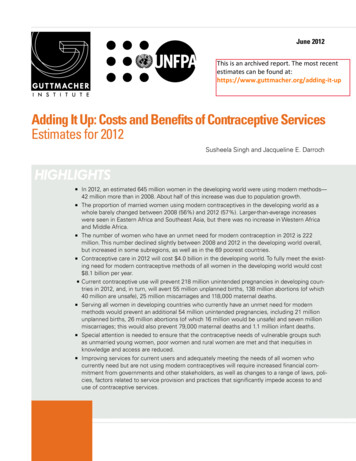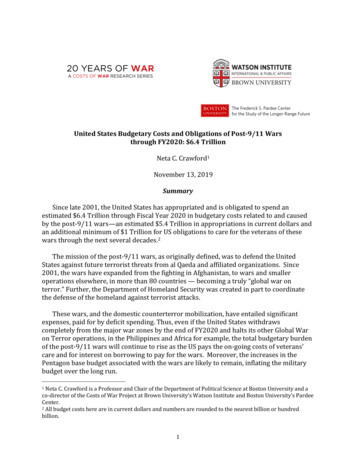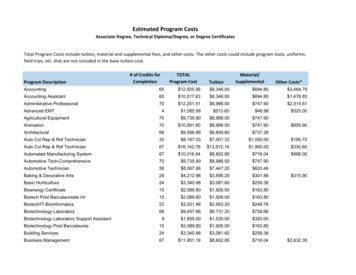
Transcription
June 2012This is an archived report. The most recentestimates can be found at:https://www.guttmacher.org/adding-it-upAdding It Up: Costs and Benefits of Contraceptive ServicesEstimates for 2012Susheela Singh and Jacqueline E. DarrochHIGHLIGHTSnnnnnnnnIn 2012, an estimated 645 million women in the developing world were using modern methods—42 million more than in 2008. About half of this increase was due to population growth.The proportion of married women using modern contraceptives in the developing world as awhole barely changed between 2008 (56%) and 2012 (57%). Larger-than-average increaseswere seen in Eastern Africa and Southeast Asia, but there was no increase in Western Africaand Middle Africa.The number of women who have an unmet need for modern contraception in 2012 is 222million. This number declined slightly between 2008 and 2012 in the developing world overall,but increased in some subregions, as well as in the 69 poorest countries.Contraceptive care in 2012 will cost 4.0 billion in the developing world. To fully meet the existing need for modern contraceptive methods of all women in the developing world would cost 8.1 billion per year.Current contraceptive use will prevent 218 million unintended pregnancies in developing countries in 2012, and, in turn, will avert 55 million unplanned births, 138 million abortions (of which40 million are unsafe), 25 million miscarriages and 118,000 maternal deaths.Serving all women in developing countries who currently have an unmet need for modernmethods would prevent an additional 54 million unintended pregnancies, including 21 millionunplanned births, 26 million abortions (of which 16 million would be unsafe) and seven millionmiscarriages; this would also prevent 79,000 maternal deaths and 1.1 million infant deaths.Special attention is needed to ensure that the contraceptive needs of vulnerable groups suchas unmarried young women, poor women and rural women are met and that inequities inknowledge and access are reduced.Improving services for current users and adequately meeting the needs of all women whocurrently need but are not using modern contraceptives will require increased financial commitment from governments and other stakeholders, as well as changes to a range of laws, policies, factors related to service provision and practices that significantly impede access to anduse of contraceptive services.
CONTENTSContext and Goal of this Report.3Need for and Use of Modern Contraceptives.4Costs and Benefits of Meeting theNeed for Modern Contraception.10June 2012 (Updated June 26, 2012)Adding It Up: Costs and Benefits of ContraceptiveServices—Estimates for 2012Susheela Singh and Jacqueline E. DarrochConclusions and Implications.17Appendix: Methodology and Data Sources.19References.24AcknowledgmentsThis report was written by Susheela Singh and JacquelineE. Darroch. Haley Ball edited the report, and KathleenRandall supervised production. All are affiliated with theGuttmacher Institute.The authors thank Guttmacher colleagues Suzette Audamfor data processing; Carolyn Cox, Allison Grossman andJesse Philbin for research assistance; and Fatima Juarezfor producing special tabulations for Mexico. They alsothank consultant Eva Weissman for updating cost data.They acknowledge the following Guttmacher colleagueswho reviewed drafts of this report: Akinrinola Bankole,Sharon Camp, Susan Cohen, Patricia Donovan, GustavoSuarez, Michael Vlassoff and Jonathan Wittenberg. In addition, they are grateful to Trevor Croft and Sarah Bradley,of MEASURE DHS, ICF International, for producing specialtabulations of unmet need, using the revised definition,from all Demographic and Health Surveys.The authors thank the following external reviewers for providing comments on the draft: Sarah Bradley, MEASUREDHS, ICF International; Beth Fredrick, Gates Institute;Nyovani Madise, University of Southampton; Scott Radloff,U.S. Agency for International Development; Sara Seims,David and Lucile Packard Foundation; John Skibiak, Reproductive Health Supplies Coalition; John Stover, FuturesInstitute; Amy Tsui, Bloomberg School of Public Health, TheJohns Hopkins University; and Charles Westoff, PrincetonUniversity. They are also grateful for comments providedby Howard Friedman, Desmond Koroma, Edilberto Loaizaand Jacqueline Mahon, of United Nations Population Fund(UNFPA).This report was funded by grants from the UK Departmentfor International Development and the Bill & Melinda GatesFoundation. The findings and conclusions contained withinare those of the authors and do not necessarily reflectpositions or policies of the donors.The Guttmacher Institute gratefully acknowledges thegeneral support it receives from individuals and foundations—including major grants from The William and FloraHewlett Foundation, the David and Lucile Packard Foundation and the Ford Foundation—which undergirds all of theInstitute’s work. Guttmacher Institute, 2012Suggested citation: Singh S and Darroch JE, Adding It Up:Costs and Benefits of Contraceptive Services—Estimatesfor 2012, New York: Guttmacher Institute and UnitedNations Population Fund (UNFPA), 2012, pdf .www.guttmacher.org
Context and Goal of this ReportGrowing concerns about inadequate progress in advancingmaternal and reproductive health over the last two decadeshave sparked a number of efforts, now underway, to increase attention, support and resources for family planningin developing countries. Some key examples of these effortsare the HandtoHand Campaign; the Alliance for Reproductive, Maternal and Newborn Health; the Partnership forMaternal, Newborn and Child Health; Women Deliver;activities to monitor relevant milestones for global development and poverty alleviation (ICPD 20 and the MDG 15);initiatives by donor agencies and foundations, and the 2012London Summit on Family Planning.1–7 One goal that theseinitiatives have in common is to increase access to contraceptive services and thereby better serve women who wantto delay or stop childbearing, because doing so will reduceunintended pregnancy, help women and couples attain theirdesired family size and better time their pregnancies, andprevent many deaths and disabilities related to pregnancy.8In addition to these short-term health benefits, increasedprevention of unintended pregnancies would have broader,longer-term benefits for women, families and society, ranging from increased education for women and better childhealth to greater family savings, lower rates of populationgrowth and stronger national economies.9,10A 2009 study, Adding It Up: The Costs and Benefits ofInvesting in Family Planning and Maternal and NewbornHealth, highlighted these issues by quantifying the numberof women with an unmet need for modern contraceptiveservices—215 million women in the developing world in2008.11 This study also estimated the costs and benefits ofaddressing unmet need for contraceptive services. Withthese estimates in mind, some initiatives have set goalsto increase the number of women using modern methodsin certain groups of focus countries. The United Nations’Every Woman Every Child initiative and others are currentlyassessing progress toward meeting women’s contraceptiveneeds, as well as the additional efforts needed to continueimproving access to modern family planning services,and some countries have set their own goals for specificincreases in the numbers of new contraceptive users.12These initiatives have generally set their goals in termsof expected increases in the number of users of modernmethods because this is a direct and straightforward indica-Guttmacher Institutetor that typically increases in response to interventions.For example, the London Summit on Family Planning islaunching an effort to make modern contraceptive servicesavailable to an additional 120 million women in the world’spoorest 69 countries by 2020.13 An underlying goal of theseinitiatives is to also reduce the number of women whohave an unmet need for modern methods. However, thisindicator is less often used to measure progress becauseunmet need may increase—even as the number of modernmethod users rises—in response to couples’ increasingdesire for smaller families and better control over the timingof pregnancy.This report presents new 2012 estimates of the numbers and proportions of women in the developing worldusing modern methods and in need of modern contraception, as well as the cost and impact of meeting this need.*The 2012 Adding It Up estimates are comparable to thosefrom the 2009 report and will therefore enable us to assess progress between 2008 and 2012. The estimates presented here incorporate the most recent available surveydata on need for and use of contraception and updated2012 estimates of the direct costs of providing contraceptive services. They also draw on updated estimates ofpregnancies and maternal deaths. In some cases, wheremore recent information is not available, we draw on measures from the 2009 analysis—the most important suchinstance being estimates of program and systems costs(see Appendix, pages 19–22, for more detail).We present estimates in this report for all developing countries (as defined by the United Nations StatisticsDivision), for the three major regions (Asia, Africa, and LatinAmerica and the Caribbean), for 14 subregions and for the69 poorest countries in the developing world (AppendixTable 1, page 23).14,15 The goal of this report is to informthe decisions and activities of donors, developing country governments and advocates aimed at improving andexpanding access to contraceptive services for all womenand couples in developing countries.*We plan to publish a more comprehensive set of estimates, including other sexual and reproductive health services, in early 2014.3
Need for and Use of Modern ContraceptivesThe widespread shift in the developing world from largefamilies to smaller families is arguably one of the mostimportant social transformations of the 20th century, andit parallels a similar transition that took place in the developed world much earlier and at a much slower pace.16,17Starting from an average of more than five children perfamily in the 1970s, couples in the developing world hadabout 2.5 children on average in the decade 1994–2005,although the range across countries has remained verywide.18While many factors have had a role in this transformation in childbearing, one of the main mechanisms throughwhich smaller family size has been achieved is theincreased use of contraception, made available throughpublic sector family planning programs, nongovernmental organizations and the private sector, including clinicsand pharmacies.19–22 Compilations of data by the UnitedNations show that the use of modern contraceptivemethods by married women* aged 15–49 in the developing world rose from negligible levels in the 1960s to anestimated 47% in 1990 and 55% in 200023 and has sincestabilized, remaining at this level in 2009.24 At the sametime, the motivation to have small families and to better time births remains strong and is increasing in manyparts of the developing world.25 Other worldwide trends,such as increasing levels of sexual activity among young,unmarried women—related to a rising age at marriage26 —imply a growing need for effective contraception amongthe unmarried. In this chapter we discuss the current situation and recent trends in regard to existing needs and theuse of modern contraception.Need for contraceptive servicesWhile the large majority of women are sexually active formuch of their reproductive years, most want only a few*In this report, “married women” refers to those who are legallymarried, cohabiting or in a consensual union. “Formerly married”refers to women who have previously been in a union and werenot in union at the time of interview, and “never married” refersto women who have never been in union.†We consider unmarried women sexually active if they reportedhaving had sex in the three months prior to being surveyed.4children. To achieve their desired family size and avoidunintended pregnancies, they will spend most of this timein need of contraception (see box). In 2012, of the 1,520million women of reproductive age in the developingworld, 57%, or an estimated 867 million, are in need ofcontraception.27 Most of these women are using a modern contraceptive method (645 million), but a significantminority are not, and these women have an unmet needfor modern contraception (222 million; Figure 1).Another 653 million women—43% of all women ofreproductive age—do not currently need contraception.27More than half of these women (24% of all women ofreproductive age) are unmarried and not sexually active;†the remaining women have recently had an intended birth,are currently pregnant with an intended pregnancy orwant to be pregnant soon (11%), or are sexually active butare infecund (8%). As women’s contraceptive needs andDefining the need for modern contraceptionn Women of reproductive age (15–49) are considered to be in need of contraception if they areusing contraceptives—modern or traditional—orare using no method but are married or areunmarried and sexually active (i.e., had had sexin the three months prior to being surveyed), arefecund and do not want a child soon (in the nexttwo years) or at all; identify their current pregnancy as unintended; or are experiencing postpartum amenorrhea after an unintended pregnancy.n Women in need who are not currently using amodern contraceptive method—that is, womenwho use no method or a traditional method—areconsidered to have an unmet need for modernmethods. Women who use traditional methodsare included as having unmet need for moderncontraception because the methods they areusing are more likely to fail than modern methods. Modern methods include male and femalesterilization, IUDs, implants, injectables, pills,male condoms and other supply methods, suchas spermicides and female condoms. Traditionalmethods mainly include withdrawal and periodicabstinence.Guttmacher Institute
life circumstances vary over their reproductive lifespan,women will move between needing and not needing contraception, and many will move between using modernmethods and having unmet need. The current estimatespresented here represent a snapshot of the status of allwomen in developing countries in 2012.Use of modern contraceptive methodsOf the 645 million women in the developing world usingmodern methods of contraception in 2012, the largemajority are married (596 million), an estimated 20 millionhave previously been married, and 29 million have neverbeen married (data not shown).27 We focus on moderncontraceptive methods because of their higher effectiveness in preventing pregnancy, compared with traditionalmethods, such as withdrawal and periodic abstinence.In 2012 in the developing world, modern methods areused by 57% of married women (on whom data are morecomplete and arguably better reported, compared withother groups; Table 1, page 6).27 The level of use is higherin some subregions (an estimated 88% in Eastern Asiaand 70% in South America), and lower than average inothers (17% in Sub-Saharan Africa, 34% in Western Asiaand 46% in South Asia). In the 69 poorest countries in theworld, 40% of married women are using modern methodsin 2012.Between 2008 and 2012, the number of modernmethod users increased by 42 million in the developingworld as a whole, an average annual increase of roughly10 million users.27,28 In comparison, between 2003 and2008, the number of modern method users rose by almost 100 million in developing countries, from 504 millionto 603 million, an annual increase of 20 million users (notshown).28 The increase between 2008 and 2012 was partlydue to population growth (52%), and partly to the smallincrease in the contraceptive prevalence rate (48%). Forexample, the proportion of currently married women in thedeveloping world using modern methods barely changedbetween 2008 (56%) and 2012 (57%).27 Stabilization inthe level of modern contraceptive use in recent yearshas been reported elsewhere for some countries, and isconsistent with these updated aggregate estimates.29Despite overall stabilization, there have been some important changes within regions. More substantial increases inmodern method prevalence rates among married womenwere seen in Eastern Africa (from 20% in 2008 to 27% in2012) and in Southeast Asia (from 50% to 56%).27 Notably,there was no increase in Western Africa and MiddleAfrica, areas where modern contraceptive use continuesto be very low. In these subregions, health systems areespecially weak and mortality rates very high, and theGuttmacher InstituteFigure 1. More than half of all reproductive-agewomen in developing countries are in need ofmodern contraceptives.8%11%42%24%15%1,520 million womenIn needUses modern contraceptivesHas unmet need for modern contraceptivesNot in needUnmarried and not sexually activeWants a child soon or is pregnant/postpartumwith intended pregnancyInfecundSource: reference 27need for comprehensive care that includes contraceptive,maternal, infant and child health services—relevant for allcountries—is particularly great.These different regional trends are illustrated by somecountry examples (Figure 2, page 7).30–35 Ethiopia, Malawiand Rwanda saw substantial increases, while India, Nepal,Nigeria, Pakistan and Zimbabwe witnessed less changein recent years. All countries that have experienced littlerecent growth in contraceptive prevalence need attention,but the situation of countries such as Nigeria and Pakistan,where change is slow and modern method use is verylow, requires particularly careful examination to determinehow to meet existing contraceptive needs.Never-married women make up a large and importantgroup that accounts for 26% of all women aged 15–49in the developing world in 2012 and comprises mostlyadolescents and young adult women aged 15–24.27 Therehas been a steady long-term trend toward increased levelsof sexual activity among these women due to a combination of factors: the declining age of menarche, the risingage at marriage and changing societal values.26 When5
TABLE 1. Number of women aged 15–49 using modern contraceptive methods and proportion of marriedwomen aged 15–49 using modern methods and annual percent change, by region and subregion of thedeveloping world and for the 69 poorest countries, 2008 and 2012.Region and subregionDeveloping worldAfricaSub-Saharan Africa*Eastern AfricaMiddle AfricaSouthern AfricaWestern AfricaNorthern AfricaAsiaEastern AsiaCentral AsiaSouth AsiaSoutheast AsiaWestern AsiaOceaniaLatin America & the CaribbeanCaribbeanCentral AmericaSouth America69 poorest countries†Among all women aged 15–49,number using modern methods (millions)Among married women aged 15–49% using modern 1.71.42292522.639400.7Annual% changeAnnual% change*Sub-Saharan Africa includes Sudan and South Sudan, both of which are in the Northern Africa region. †An analysis for the LondonSummit on Family Planning, projecting the percentage of women using modern methods based on the linear rate of change betweenthe two most recent surveys, estimated that 258 million women in the 69 poorest countries were using modern methods in 2012, sixmillion more than the 252 million shown here, which is based on the most recent information available without projection.Sources: 2008—Reference 11; 2012—reference 27.they become sexually active, young never-married womenface much greater difficulties in obtaining contraceptivesthan do married women, in large part because of thestigma attached to being sexually active before marriage.Information on the level of and trends in contraceptive useamong never-married sexually active women is thus ofgreat relevance for policymakers and program planners.However, data on the sexual and reproductive behaviorof never-married women are limited (especially in Asia andNorthern Africa), and underreporting of sexual activity andcontraceptive use is likely high in these regions. In SubSaharan Africa and Latin America and the Caribbean, dataon unmarried women are more plentiful and of better quality than in other regions, although underreporting may stillbe significant. Because of these constraints, we supplemented available national survey data with estimates fromsubnational studies in Asia and Northern Africa to estimatethat 52 million never-married women in the developingworld as a whole are sexually active and in need of con-6traceptives to prevent pregnancy in 2012.27 About 56% ofnever-married women in need are using modern contraceptive methods, with some variation across regions:49% in Asia, 55% in Sub-Saharan Africa and 69% in LatinAmerica and the Caribbean; and in the 69 poorest countries, the equivalent proportion is 41% (not shown).The disadvantage that never-married women have inobtaining contraceptives is apparent in the following statistics: In the developing world as a whole, among womenin need of contraceptives, use of modern methods is 20percentage points lower among never-married womenthan among married women (not shown).27 In Asia, thisdifference is 31 percentage points; in Latin America andthe Caribbean, it is 10; and in the 69 poorest countries,it is 20 percentage points. The situation is reversedin Sub-Saharan Africa, where the proportion of nevermarried women in need using modern contraceptives is19 percentage points higher than among their marriedcounterparts, an indication of the strength of motivation ofGuttmacher Institute
Figure 2. Some countries have seen rapid increases in contraceptive prevalence since 2000,while others have seen little improvement.100Ethiopia90Rwanda80India% of married women 15–49 using modern 0201001980198519901995200020052010Source: references 30–35.unmarried women to avoid childbearing before marriageand HIV/STI infection, as the condom is the predominantmethod used by never married women in this region.ing world women with an unmet need for modern contraception declined slightly between 2008 and 2012, from226 million (using the revised methodology) to 222 million(Table 2, page 8).27,† However, the number of women withan unmet need for modern contraception increased inUnmet need for modern methods of contraceptionmost of Africa and in some subregions of Asia and LatinWomen and their partners who are able to have a childAmerica and the Caribbean. Unmet need for modernbut are not using contraceptives or are using a traditionalcontraception in the 69 poorest countries—which accountmethod have much higher chances of having an unintendfor 73% of all unmet need in the developing world—alsoed pregnancy than those who use modern methods. As aincreased, from 153 to 162 million women in 2008–2012.1986result, unmet needfor modernmethods1989is a key indicator1981 19821988The proportion of married women with unmet need1983of the burden of unfulfilled1984 demand for contraceptive ser199819871997 contraception is 18% in theformodernvices (see box, page 4). In 2012, an estimated 2222007developing world1991million20031996199319922006than average (30–37%) inasawhole,butismuchhigher2001women in the developing world have an unmet need for20022008and WesternWestern 1999Africa,2004Middle Africa, Eastern Africamodern contraception.27 Comparable estimates were calAsia, and is somewhat higher than average (22–24%)culated for 2008 and 2012, applying the recently released1994in South Asia and the Caribbean (Figure 3).27 In general,36revised methodology for calculating unmet need to bothamong subregions, use of modern contraceptivemethods2009years (see Appendix, pages 20–21).*Although increases in the use of modern contraceptives will reduce the number of women with unmet needin the long term, this number may increase in the shortrun because of population growth and because the proportion of women and couples who want smaller families andgreater control over the timing of births continues to grow.Our updated estimates show that the number of develop-Guttmacher Institute*Although the calculation methodology was revised, the conceptremains the same.†The number of women with unmet need for modern methodsin 2008 was previously estimated to be 215 million (see reference 11). We revised this estimate by applying the new unmetneed calculation methodology (discussed in the Appendix), whichresulted in a revised estimate of 226 million women in 2008.7
TABLE 2. Number of women with unmet need for modern methods and proportion with unmet need formodern methods among all women in need of modern contraception, by region and subregion of thedeveloping world and for the 69 lowest-income countries, 2008 and 2012.Region and subregionDeveloping worldAfricaSub–Saharan Africa†Eastern AfricaMiddle AfricaSouthern AfricaWestern AfricaNorthern AfricaAsiaEastern AsiaCentral AsiaSouth AsiaSoutheast AsiaWestern AsiaOceaniaLatin America & the CaribbeanCaribbeanCentral AmericaSouth America69 poorest countries‡Women 15–49 with unmet needfor modern methods (millions)% of women 15–49 in need of contraceptionwho have unmet need for modern methods2008*2012Annual% 3792515 �0.62012Annual% change*Revised from prior estimates (see references 11 and 28) using new specifications for calculating unmet need. †Sub–Saharan Africa includes Sudan and South Sudan, both of which are in the Northern Africa region. ‡An estimate of the number of women with unmet needfor modern methods in the 69 poorest countries consistent with the London Summit on Family Planning projected number of 258 millionwomen using modern methods (see footnote, Table 1) would be 160 million, compared with the 162 million shown in the table, which isbased on the most recent available information.Sources: 2008 and 2012––reference 27.is higher where unmet need is lower.The small overall decline in unmet need for modern methods is more impressive than it appears at firstglance, given an increase in the number of women whowant to avoid pregnancy, from 829 million in 2008 to 867million in 2012.27 In the developing world as a whole, theproportion of women in need with an unmet need formodern methods declined by 1.7 percentage points, from27.2% to 25.5%, between 2008 and 2012; the annual rateof decline was 1.5%. The annual rate of decline was aboveaverage in Eastern Africa, Southern Africa, Eastern Asia,Southeast Asia and South America (ranging from –3.5%to –8.6%, Table 2). Declines were much less than averagein South Asia (–0.4%) and in the 69 poorest countries(–0.6%). There was essentially no change in MiddleAfrica, Western Africa and Central America. Unmet needincreased in Northern Africa and Oceania—regions wherebetter data for 2012 may underlie this unexpected trend.8The need to improve modern method useIt is understandable that the level of unmet need formodern contraceptives generates so much attention,since nonuse and traditional method use put women andtheir partners at highest risk of unintended pregnancy, andsince the measure has, in some form, long been includedin national surveys and reports. However, measuringcontraceptive prevalence alone (whether or not women ortheir partners are using a modern method) does not capture all the barriers that underlie non-use of contraception,incorrect use and discontinuing use—all of which can result in unintended pregnancy. Some women may not usecontraception and some current users of modern methodsmay stop use, even though they do not want to becomepregnant, for a number of reasons, including having concerns about health and side effects, perceiving that theyare not at risk of pregnancy, facing opposition from theirpartners or others, having inadequate knowledge aboutGuttmacher Institute
Figure 3. There are large variations in married women’s level of unmet need for and use of moderncontraception among subregions of the developing world in 2012.Developing worldD1857Sub-regions of the developing worldWestern Africa309Middle Africa7373227Eastern AfricaNorthern Africa2145Southern Africa1658Western Asia3534South Asia46241952Central Asia56Southeast Asia20Eastern Asia88 32256Caribbean64Central America181770South America020406080100% married women 15–49Modern contraceptive useUnmet need for modern contraceptionSource: reference 27.methods and having problems getting supplies (due to factors such as distance, cost, stock-outs and inconvenienthours).37 In addition, they may use their method inconsistently or incorrectly because of inadequate counseling orinformation, because using the method is inconvenient orbecause of the type of relationship they have.38,39 Switching methods may be difficult, for example, if a woman’sprovider does not offer other methods or is unwilling tofacilitate the process of switching methods, or if preferredmethods are too expensive or are unavailable locally.Improving the quality of information and servicesoffered to contraceptive clients would likely improve effectiveness of use. This could be achieved by providing aGuttmacher Institutebroad choice of methods, continuous supplies, coun
Health, highlighted these issues by quantifying the number of women with an unmet need for modern contraceptive services—215 million women in the developing world in 2008. 11. This study also estimated the costs and benefits of addressing unmet need for contraceptive services. With these estimates in mind, some initiatives have set goals











